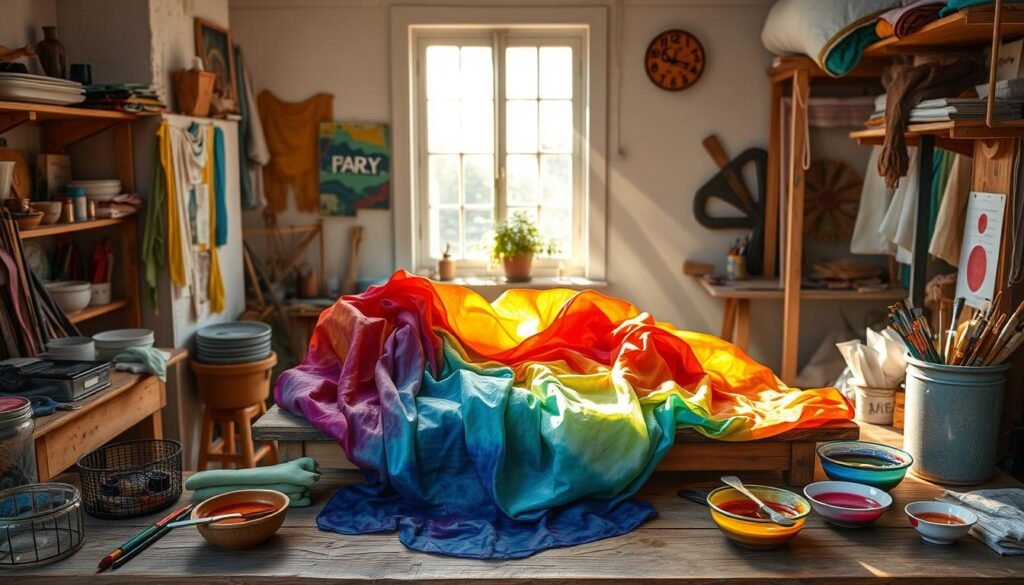Silk is a natural fiber known for its luxurious look and feel. It also takes colors well. So, can you dye silk fabric at home? Yes, you can! Dyeing silk lets you customize your clothes, accessories, or home decor. This guide will show you how to dye silk using acid dyes1, fiber-reactive dyes, and natural dyes1. Get ready to make your silk fabrics shine and show off your creativity!
Key Takeaways
- Silk is a versatile natural fiber that can be dyed using a variety of methods, including acid dyes, fiber-reactive dyes, box dyes, and natural dyes.
- Acid dyes are considered the best and most reliable choice for dyeing silk, offering vibrant and permanent colors1.
- Natural dyes can provide eco-friendly color options and a creative way to experiment with different shades1.
- Proper pre-washing and record-keeping are essential for successful silk dyeing projects1.
- Blended silk fabrics can complicate the dyeing process, requiring careful consideration of fiber content1.
What is the Best Way to Dye Silk Fabric?
There are many ways to dye silk fabric, each with its own good and bad points. You can pick from acid dyes for bright colors or natural dyes for something eco-friendly23.
Acid Dyes
Many silk lovers choose acid dyes for their vibrant, lasting colors. These dyes stick to silk well, making the colors fade-resistant3. They work on silk, wool, alpaca, and even nylon, making them handy for home dyeing.
Fiber-Reactive Dyes
Fiber-reactive dyes, or procion dyes, are mostly for cotton and linen but work on silk too. They bond strongly with silk, giving colors that last a long time3.
Box Dyes
Box dyes like Rit and Dylon are easy on the wallet for one-time dyeing projects. They come ready to use but might not give the same bright, lasting colors as professional dyes3.
Natural Dyes
Natural dyeing is great for those who want to be eco-friendly. It uses plants and special techniques like eco-printing for unique colors2. It’s a fun and rewarding way to dye silk, even if the results can vary.
No matter the dyeing method, getting ready and following the instructions is key for great results with silk3. With the right steps, you can create vibrant, lasting colors and unique silk items23.
Can You Dye Silk Dresses, Clothes, and Curtains?
Absolutely! Silk can be dyed in many ways, including clothes and home decor. Dyeing silk dresses, clothes, and curtains is possible for those who love DIY projects. It’s all about knowing how silk works and how to dye it right.
Remember, the fabric must be 100% silk. Mixing other fabrics can lead to bad dye results4. The item must also handle washing and dyeing well without losing its shine. Make sure it’s big enough to move in the dye and fix any stains first.
Choosing the right dye is key, whether it’s natural, acid, or fiber-reactive5. Pre-washing the item and following dye instructions carefully can help get the best color6.
With careful planning and the right steps, you can dye silk items to match your style. This can be a fun and money-saving way to refresh old items or start new projects. It’s a great way to make unique, high-quality pieces.
Dyeing Silk Blended Fabrics
Dyeing silk fabrics is easy, but silk blends are a bit tricky. When silk is mixed with cotton, polyester, or nylon, it gets complicated7. You need to know how each fiber acts with the dye.
Tips for Dyeing Silk-Blend Fabrics
Here are some tips for dyeing silk-blend fabrics:
- Test a swatch first: Always test a small piece before dyeing the whole fabric. This shows how the dye and method work with the blend7.
- Consider the fiber content: Wool or nylon blends can be dyed like pure silk. But cotton or polyester blends might need more trial and error7.
- Be aware of absorption differences: Silk mixed with nylon might take dye too fast and deeply. This can cause uneven color. Adjust the dye and time as needed7.
- Adjust dye application: For fabrics with cotton, try dyeing directly with painting or printing. Immersion dyeing might not work well7.
Dyeing silk blends takes more effort and care, but you can get great results. Always test a small piece first. Adjust your dyeing based on the fabric’s unique mix.
“The key to successfully dyeing silk blends is understanding the nuances of the different fibers and how they interact with the dye.” – Jane Doe, Textile Dye Expert2
| Fiber Blend | Dyeing Considerations |
|---|---|
| Silk-Cotton | May need different dye methods, like direct application, for even color7. |
| Silk-Polyester | Dyeing evenly can be tough with polyester blends7. |
| Silk-Nylon | Silk mixed with nylon takes dye too fast and deeply. Adjust dye amounts and time7. |
By knowing how silk blends work and adjusting your dyeing, you can make the most of these lovely fabrics8.
Tips Before Dyeing Silk
Before you start dyeing silk, make sure you follow some important steps. This will help make the process safe and go smoothly9. First, cover your work area with plastic sheeting and newspaper to catch any spills9. Also, wear long gloves, an apron, and a dust mask to protect your skin and lungs from the dye9.
It’s very important to clean up any dye powder spills right away. This stops stains on surfaces and clothes9. When mixing the dye, use tongs or your gloved hands to spread the color evenly9. Also, keep track of your dye recipe. This way, you can make the same colors and techniques again9.
- Prepare your work area by covering surfaces with plastic sheeting and newspaper.
- Wear protective gear, including long gloves, an apron, and a dust mask.
- Immediately clean up any spilled dye powder to prevent staining.
- Use tongs or gloved hands to agitate the dye bath for even color distribution.
- Carefully document your dye recipe details for future reference.
By taking these easy steps, you can dye silk safely and get the colors you want10. Remember, getting ready and being careful are crucial when dyeing silk10.
“Dyeing silk is a delicate and rewarding process, but it’s essential to prioritize safety and preparation to achieve the best results.”
How to Dye Silk Using Acid Dyes or Fiber-Reactive Dyes
Dyeing silk with acid or fiber-reactive dyes gives it vibrant colors that last. First, make sure the silk is clean and dry. This step opens up the fibers for better dye absorption10.
Step 1: Pre-wash and Dry Your Silk
It’s key to wash the silk before dyeing. This removes any leftover detergent or oils that could mess with the dye. It also makes sure the fabric doesn’t shrink later10.
Step 2: Record the Weight of Your Dry Item
Knowing how much the silk weighs is important. It helps you figure out how much dye and other supplies you need. This ensures your dye job turns out even and consistent10.
Acid dyes work great on silk because they stick well to the fibers. They make bright, lasting colors10. Fiber-reactive dyes can work on silk too, with some special prep. They form strong bonds that don’t fade easily10.
For dyeing silk, use fabrics like Silk Habotai and others. They’re perfect for making different kinds of clothes10.
Follow the dye instructions carefully. Start with one teaspoon of dye powder for every pound of fabric10. Dye silk in warm to hot water, around 140°F (60°C). Stir the fabric often to make sure the color spreads evenly10.
To fix the color, use heat or a vinegar rinse. Let the dyed silk dry in a cool, airy spot. This helps keep the color bright and the fibers strong10.
“Acid dyes are great for wool, silk, and nylon. They need hot water to work and can be used in a washing machine. But, they work better on the stove top.”11
Acid dyes are fast-acting and make colors that last. They’re also light and wash well11. Jacquard acid dye is safe if handled right. Use a dye mix of 4% to 8% for painting11.
To make the dye thickener paste, mix it with water, urea, and vinegar. Stir it for 10 minutes11. How much dye you need depends on how deep you want the color to be. It can be from 0.25 to 3 ounces11.
Acid dyes dissolve in hot water and have different wash and light resistance levels. These levels depend on the color’s properties11.
How to Dye Silk Using Fiber-Reactive Dyes Without a Stovetop
Dyeing silk with fiber-reactive dyes is easy and fun. You don’t need a stovetop or hot dye bath. Just soak the silk in a dye solution and let it sit to develop color12. This is great for small projects or delicate silk that can’t handle high heat.
- First, make sure your silk is clean and free of oils or finishes that could mess with the dye12.
- Then, figure out how much dye and helpers you need based on the silk’s weight12.
- Follow the dye instructions to mix the dye with water. Make sure the dye covers the silk completely when it’s in the water.
- Soak the silk in the dye solution until it gets the color you want, usually 6-12 hours12.
- After the color is right, rinse the silk under cold water to get rid of extra dye. Then, wash it in mild soap to fix the color.
Patience and following the dye instructions are key for cold-water silk dyeing12. This way, you can get bright, lasting colors on your silk without a hot dye bath13.

The type of dye and how you prepare the fabric affects the final look13. Always test a small piece first to make sure you like the result13. With some practice, dyeing silk with fiber-reactive dyes without a stovetop is easy13.
Can You Dye Silk Fabric? A Step-by-Step Guide
Yes, you can dye silk fabric and make it look amazing. This guide will help you turn plain silk into something special. It’s great for both experts and beginners in textile arts14.
First, learn about the different dyes for silk. Acid dyes work well with silk and keep the colors bright3. Fiber-reactive dyes also work great, giving silk a strong color that lasts3. If you like natural colors, try natural dyes made from plants3.
- Wash and dry your silk first to remove any finishes that could affect the dye.
- Know the weight of your silk to get the right dye amount for even color.
- Follow the dye instructions carefully, keeping an eye on the temperature and how much you stir.
- Soak the silk in the dye mix until it’s fully colored. Let it sit as long as the instructions say.
- Wash the dyed silk well to get rid of any extra dye. This helps prevent color from fading or running.
- Set the dye by steaming or heat-setting the silk, as the dye instructions suggest. This keeps the color bright and lasting.
Pay close attention and be patient when dyeing silk. By following these steps, you can make beautiful, unique silk items14.
For something different, try dyeing silk with candy like rainbow lollipops for tie-dye effects15. Soak the silk in an acid mix, then heat it with the candy dye to fix the color15. This method can create stunning, one-of-a-kind silk pieces.
Whether you pick traditional dyes or candy dyeing, this guide will help you dye silk at home. Get ready to make your silk projects stand out14.
How to Dye Silk Using Natural Dyes
Silk is a luxurious, natural fiber that can be beautifully dyed using eco-friendly techniques. You can use the hot dyeing, solar dyeing, eco printing, bundle dyeing, hapazome, and tie dyeing methods. These natural dyeing silk methods offer many colors and artistic ways to express yourself. Each method has its own process and materials for silk fabric, yarn, and garments.
Hot Dyeing Method (Immersion Dyeing)
The hot dyeing method is a popular way to dye silk with natural dyes. It involves heating the silk in a dye bath at 85°C (185°F) or less. This lets the silk absorb the plant-based silk dyes evenly16. Some colors might need an overnight soak for the best color16.
Solar Dyeing
Solar dyeing uses the sun’s heat to dye silk. You soak the silk in dye and let it sit in the sun for days or weeks. This method gives soft, muted colors.
Eco Printing
Eco printing, or botanical printing, uses plants to create unique patterns on silk. You wrap silk around plants and steam or boil it. This transfers the plant’s colors onto the silk, making beautiful patterns.
Bundle Dyeing
Bundle dyeing is similar to eco printing. You wrap silk around plants and steam or boil it. This infuses the silk with natural dyes, creating detailed patterns and textures. You can use many plants for this method.
Hapazome (Flower Pounding)
Hapazome is a Japanese technique that uses flowers and leaves to dye silk. You pound the plants onto the silk, transferring their colors and shapes. This creates delicate, botanical designs.
Tie Dyeing
Tie dyeing is a fun way to make unique patterns on silk. You bind parts of the silk with string or rubber bands. Then, the undyed parts create patterns when you rinse the silk17.
Choosing any natural dyeing method, silk’s great color-absorbing ability makes it perfect for eco-friendly silk dyeing. With some creativity, you can make stunning, unique pieces18.
Types of Silk Best for Dyeing
Not all silks are the same when it comes to dyeing. Mulberry, eri, and tussah silk each have special qualities that affect dyeing. Pongee, habotai, silk satin, dupion, and tussah silk are top choices for dyeing. They have a strong yet soft texture that makes colors pop and last19.
- Habotai silk is great for painting because it dyes beautifully19.
- Silk Twill is good for men’s and women’s shirts and other clothes19.
- Silk Habotai is perfect for scarves and keeping warm in the cold19.
- Silk Chiffon is ideal for summer outfits because it lets air flow freely19.
- There are different weights of silk, from 8 mommy to 12 mommy, based on thread count19.
- Sand-washed silk soaks up a lot of dye, making it look stunning19.
Before dyeing silk, there are a few things to keep in mind. It’s a good idea to wash the silk first, either by hand or in a lingerie cycle19. Don’t let silk dry in the sun, but you can air dry it inside19. Finally, iron the silk when it’s almost dry with a warm or hot iron to make it shiny and smooth19.

“Silk is a natural protein fiber, and its unique molecular structure allows it to readily accept a wide range of dyes, resulting in vibrant, long-lasting colors.”
Conclusion
Dyeing silk fabric is fun and lets you make your own clothes, accessories, and home items. You can use professional dyes like20 Jacquard Acid Dyes or try natural methods like tie-dyeing21. Silk is great for getting bright, lasting colors20.
To get the best results, prepare well and use the right dyeing method for silk20. For example, Rit DyeMore Synthetic Fiber Dye is great for dyeing silk shoes20. People like to make silk shoes in light colors20, showing how versatile and customizable silk is.
Whether you’re22 using food coloring or professional dyes, dyeing silk at home is fun. By knowing how silk works and the different21 dyeing ways, you can make beautiful, custom silk items20. From shoes to sarees, the options for2221 customizing silk are endless. This makes it a great craft for beginners and experts.
FAQ
What are the various methods for dyeing silk fabric?
There are several ways to dye silk fabric. You can use acid dyes, fiber-reactive dyes, box dyes, or natural dyes. Acid dyes and fiber-reactive dyes bond well with silk fibers. Box dyes are easy to find and natural dyes are eco-friendly.
Can you dye silk dresses, clothes, and curtains?
Yes, you can dye silk dresses, clothes, and curtains. But, make sure they are 100% silk and can handle dyeing. They should also stay washable and keep their shine.
How do you dye silk blended with other fibers?
Dyeing silk mixed with other fibers is tricky. Different fibers absorb dye at different rates. Silk blends with wool or nylon can be dyed like pure silk. But, silk mixed with cotton or polyester might need more trial and error.
What precautions should you take when dyeing silk?
Be careful when dyeing silk. Protect your work area and wear gloves and a mask. Clean up spills right away. Use tongs or gloved hands to mix the dye evenly.
What are the steps for dyeing silk using acid dyes or fiber-reactive dyes?
Start by washing and drying the silk. Then, figure out how much dye you need based on the silk’s weight. This ensures the dye spreads evenly for great results.
Can you dye silk using fiber-reactive dyes without a stovetop?
Yes, you can dye silk with fiber-reactive dyes without a stove. Just soak the silk in the dye solution and let it sit. This method doesn’t use heat.
What are the different types of natural dyeing techniques for silk?
Silk can be dyed naturally using many methods. You can try hot dyeing, solar dyeing, eco printing, bundle dyeing, hapazome, or tie dyeing. Each method uses different materials and steps to create unique colors on silk.
What types of silk are best for dyeing?
Pongee, habotai, silk satin, dupion, and tussah silk work well for dyeing. They keep colors bright and last a long time. Mulberry, eri, and tussah silk each react differently to dye.




